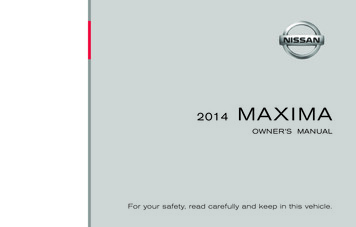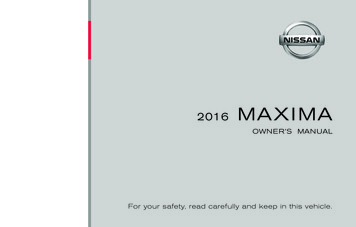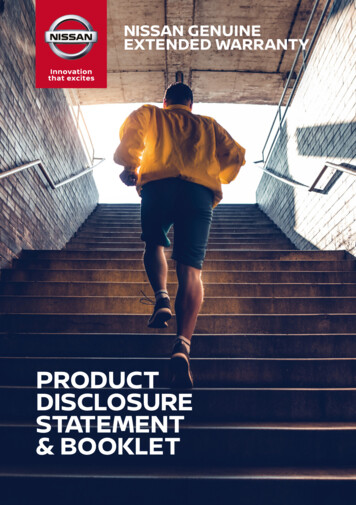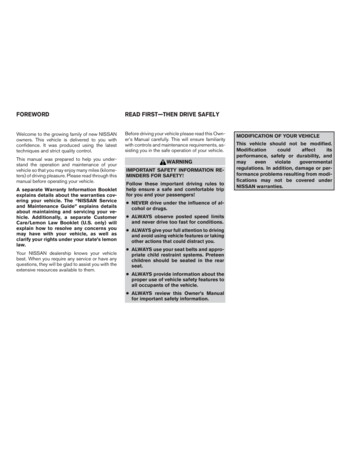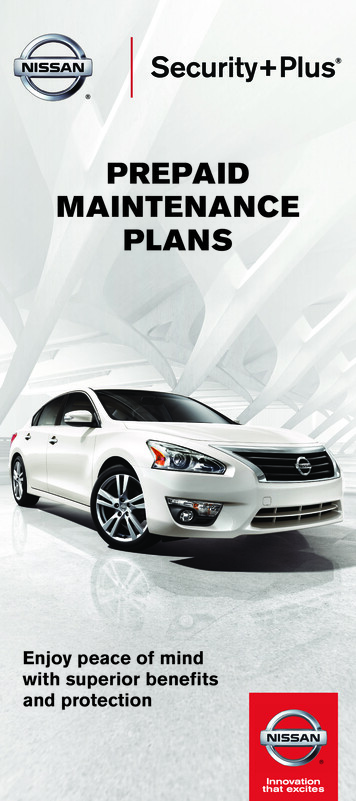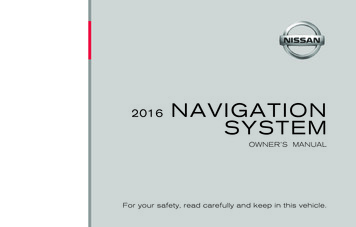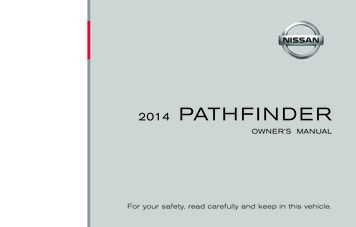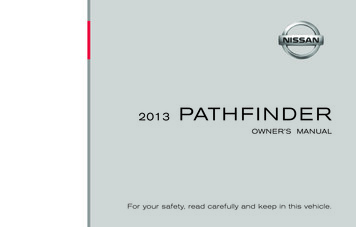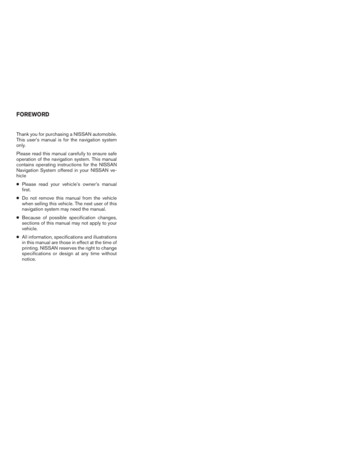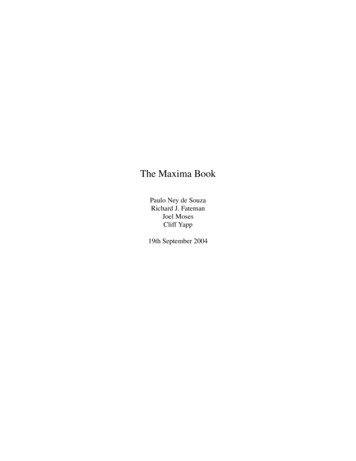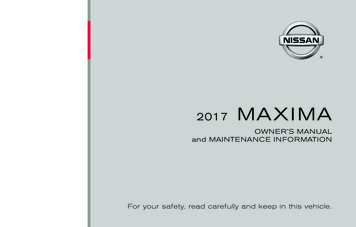
Transcription
2017MA X I MAOWNER’S MANUALand MAINTENANCE INFORMATIONFor your safety, read carefully and keep in this vehicle.
FOREWORDWelcome to the growing family of new NISSANowners. This vehicle is delivered to you withconfidence. It was produced using the latesttechniques and strict quality control.This manual was prepared to help you understand the operation and maintenance of yourvehicle so that you may enjoy many miles (kilometers) of driving pleasure. Please read through thismanual before operating your vehicle.A separate Warranty Information Bookletexplains details about the warranties covering your vehicle. The “Maintenance andschedules” section of this manual explainsdetails about maintaining and servicingyour vehicle. You will also receive a separate Customer Care/Lemon Law Booklet(U.S. only) will explain how to resolve anyconcerns you may have with your vehicle,and clarify your rights under your state’slemon law. Additionally, you may receive aseparate Navigation Manual (if soequipped) that will explain the various features and functions your system may have.A NISSAN dealership knows your vehicle best.When you require any service or have any questions, they will be glad to assist you with theextensive resources available to them.READ FIRST—THEN DRIVE SAFELYIn addition to factory-installed options, your vehicle may also be equipped with additional accessories installed by NISSAN or by a NISSANdealer prior to delivery. It is recommended thatyou visit a NISSAN dealer for details concerningthe particular accessories with which your vehicle is equipped. It is important that you familiarize yourself with all disclosures, warnings, cautions and instructions concerning proper use ofsuch accessories prior to operating the vehicleand/or accessory. It is recommended that youvisit a NISSAN dealer for details concerning theparticular accessories with which your vehicle isequipped.Before driving your vehicle, please read thisOwner’s Manual carefully. This will ensure familiarity with controls and maintenance requirements assisting you in the safe operation of yourvehicle.WARNINGIMPORTANT SAFETYREMINDERS!INFORMATIONFollow these important driving rules tohelp ensure a safe and comfortable tripfor you and your passengers! NEVER drive under the influence of alcohol or drugs. ALWAYS observe posted speed limitsand never drive too fast for conditions. ALWAYS give your full attention to drivingand avoid using vehicle features or takingother actions that could distract you. ALWAYS use your seat belts and appropriate child restraint systems. Preteenchildren should be seated in the rear seat. ALWAYS provide information about theproper use of vehicle safety features toall occupants of the vehicle. ALWAYS review this Owner’s Manualfor important safety information.
WHEN READING THE MANUALMODIFICATION OF YOUR VEHICLEThis vehicle should not be modified.Modificationcouldaffectitsperformance, safety or durability and mayeven violate governmental regulations. Inaddition, damage or performance problems resulting from modifications maynot be covered under NISSAN warranties.WARNINGInstalling an aftermarket On-Board Diagnostic (OBD) plug-in device that uses theport during normal driving, for exampleremote insurance company monitoring,remote vehicle diagnostics, telematics orengine reprogramming, may cause interference or damage to vehicle systems. Wedo not recommend or endorse the use ofany aftermarket OBD plug-in devices, unless specifically approved by NISSAN. Thevehicle warranty may not cover damagecaused by any aftermarket plug-in device.This manual includes information for all featuresand equipment available on this model. Featuresand equipment in your vehicle may vary depending on model, trim level, options selected, order,date of production, region or availability. Therefore, you may find information about features orequipment that are not included or installed onyour vehicle.All information, specifications and illustrations inthis manual are those in effect at the time ofprinting. NISSAN reserves the right to changespecifications, performance, design or component suppliers without notice and without obligation. From time to time, NISSAN may update orrevise this manual to provide Owners with themost accurate information currently available.Please carefully read and retain with this manualall revision updates sent to you by NISSAN toensure you have access to accurate and up-todate information regarding your vehicle. Currentversions of vehicle Owner’s Manuals and anyupdates can also be found in the Owner a.com/nowners/navigation/manualsGuide. If you have questions concerning any information in your Owner’sManual, contact NISSAN Consumer Affairs. Forcontact information, refer to the NISSAN CUSTOMER CARE PROGRAM page in this Owner’sManual.IMPORTANT INFORMATION ABOUTTHIS MANUALYou will see various symbols in this manual. Theyare used in the following ways:WARNINGThis is used to indicate the presence of ahazard that could cause death or seriouspersonal injury. To avoid or reduce therisk, the procedures must be followedprecisely.CAUTIONThis is used to indicate the presence of ahazard that could cause minor or moderate personal injury or damage to your vehicle. To avoid or reduce the risk, the procedures must be followed carefully.
CALIFORNIA PROPOSITION 65WARNINGWARNINGAPD1005Engine exhaust, some of its constituents,and certain vehicle components contain oremit chemicals known to the State ofCalifornia to cause cancer and birth defects or other reproductive harm. In addition, certain fluids contained in vehiclesand certain products of component wearcontain or emit chemicals known to theState of California to cause cancer andbirth defects or other reproductive harm.If you see this symbol, it means “Do not do this”or “Do not let this happen.”CALIFORNIA PERCHLORATEADVISORYIf you see a symbol similar to these in an illustration, it means the arrow points to the front of thevehicle.Some vehicle parts, such as lithium batteries, may contain perchlorate material. Thefollowing advisory is provided: “Perchlorate Material – special handling may apply.For additional information, refer rrows in an illustration that are similar to theseindicate movement or action.Arrows in an illustration that are similar to thesecall attention to an item in the illustration. 2016 NISSAN NORTH AMERICA, INC.All rights reserved. No part of this Owner’sManual may be reproduced or stored in a retrievalsystem, or transmitted in any form, or by anymeans, electronic, mechanical, photocopying,recording or otherwise, without the prior writtenpermission of Nissan North America, Inc.
NISSAN CUSTOMER CARE PROGRAMNISSAN CARES . . .Both NISSAN and your NISSAN dealer are dedicated to serving all your automotive needs. Your satisfaction with your vehicle and your NISSAN dealer areour primary concerns. Your NISSAN dealer is always available to assist you with all your automobile sales and service needs.However, if there is something that your NISSANdealer cannot assist you with or you would like toprovide NISSAN directly with comments orquestions, please contact the NISSAN Consumer Affairs Department using our toll-freenumber:For U.S. customers1-800-NISSAN-1(1-800-647-7261)For Canadian customers1-800-387-0122The Consumer Affairs Department will ask for thefollowing information:– Your name, address, and telephone number– Vehicle identification number (attached to thetop of the instrument panel on the driver’sside)– Date of purchase– Current odometer reading– Your NISSAN dealer’s name– Your comments or questionsORYou can write to NISSAN with the information at:For U.S. customersNissan North America, Inc.Consumer Affairs DepartmentP.O. Box 685003Franklin, TN 37068-5003or via e-mail at:nnaconsumeraffairs@nissan-usa.comFor Canadian customersNissan Canada Inc.5290 Orbitor DriveMississauga, Ontario L4W 4Z5or via e-mail at:information.centre@nissancanada.comIf you prefer, visit us at:www.nissanusa.com (for U.S. customers) orwww.nissan.ca (for Canadian customers)We appreciate your interest in NISSAN and thank you for buying a quality NISSAN vehicle.
Table of ContentsIllustrated table of contents0Safety—Seats, seat belts and supplemental restraint system1Instruments and controls2Pre-driving checks and adjustments3Monitor, climate, audio, phone and voice recognition systems4Starting and driving5In case of emergency6Appearance and care7Do-it-yourself8Maintenance and schedules9Technical and consumer information10Index11
0 Illustrated table of contentsAir bags, seat belts and child restraints . . . . . . . . . . . . . . 0-2Exterior front . . . . . . . . . . . . . . . . . . . . . . . . . . . . . . . . . . . . . . 0-3Exterior rear. . . . . . . . . . . . . . . . . . . . . . . . . . . . . . . . . . . . . . . 0-4Passenger compartment . . . . . . . . . . . . . . . . . . . . . . . . . . . 0-5Instrument Panel . . . . . . . . . . . . . . . . . . . . . . . . . . . . . . . . . . 0-6Engine compartment check locations . . . . . . . . . . . . . . . . 0-8Warning and indicator lights . . . . . . . . . . . . . . . . . . . . . . . . 0-9
AIR BAGS, SEAT BELTS AND CHILDRESTRAINTS1.2.3.4.Top tether strap anchor (P. 1-21)Rear head restraints/headrests (P. 1-7)Rear seat belts (P. 1-11)Roof-mounted curtain side-impact androllover supplemental air bag (P. 1-41)5. Front seat-mounted side-impactsupplemental air bags (P. 1-41)6. Front head restraints/headrests (P. 1-7)7. Front seat belt with pretensioner(s) andshoulder height adjuster (P. 1-11, 1-41)8. Supplemental air bags (P. 1-41)9. Door pressure sensor (passenger sideshown, driver’s side similar) (P. 1-41)10. Seats (P. 1-2)11. Occupant classification sensor(weight sensor) (P.1-41)12. LATCH (Lower Anchors and Tethers forCHildren) system (P. 1-21)Refer to the page number indicated in parentheses for operating details.LII22930-2 Illustrated table of contents
EXTERIOR FRONT1.2.3.4.5.Engine hood (P. 3-21)Wiper and washer switch (P. 2-39)Windshield (P. 8-16)Power windows (P. 2-55)Door locks (P. 3-4)NISSAN Intelligent Key (P. 3-7)Keys (P. 3-2)6. Mirrors (P. 3-29)Side view camera (if so equipped)(P. 4-9)7. Tire pressure (P. 8-26)Flat tire (P. 6-3)Tire chains (P. 8-26)8. Headlight and turn signal switch(P. 2-42)Replacing bulbs (P. 8-23)9. Fog light switch (P. 2-42)Daytime running light system(if so equipped) (P. 2-42)10. Front sonar sensors (if so equipped)(P. 5-85)11. Front view camera (if so equipped)(P. 4-9)Refer to the page number indicated in parentheses for operating details.LII2442Illustrated table of contents 0-3
EXTERIOR REAR1.2.3.4.5.6.7.8.Rear window defroster switch (P. 2-41)High-mounted stop light (P. 8-23)Interior trunk lid release (P. 3-22)Trunk lid (P. 3-22)Exterior trunk lid release/request button(P. 3-7)Rearview camera (P. 4-2, 4-9)Rear sonar sensors (if so equipped)(P. 5-85)Replacing bulbs (P. 8-23)Fuel-filler door (P. 3-24)Fuel recommendation (P. 10-2)Child safety rear door locks (P. 3-4)Refer to the page number indicated in parentheses for operating details.LII24430-4 Illustrated table of contents
PASSENGER COMPARTMENT1.2.3.4.5.6.7.8.Interior trunk access (P. 1-2)Power moonroof (if so equipped)(P. 2-58, 2-59)Sun visors (P. 3-28)Map lights (P. 2-62)Rearview mirror (P. 3-29)HomeLink Universal Transceiver(P. 2-64)Glove box (P. 2-51)Cup holders (P. 2-51)Console box (P. 2-51)Refer to the page number indicated in parentheses for operating details.LII2444Illustrated table of contents 0-5
INSTRUMENT PANEL1.2.3.4.5.6.7.8.9.10.11.12.13.14.LII24450-6 Illustrated table of contents15.16.Vent (P. 4-24)Headlight/fog light/turn signal switch(P. 2-42)Supplemental front-impact air bag(P. 1-41)Horn (P. 2-46)Meters and gauges (P. 2-3)Warning and indicator lights (P. 2-7)Vehicle information display (P. 2-15)Paddle shifters (if so equipped)(P. 5-15)Wiper and washer switch (P. 2-39)Audio controls*Navigation controls*Hazard warning flasher switch (P. 6-2)Navigation display*Audio display*Front passenger supplemental air bag(P. 2-36)Glove box (P. 2-51)Front passenger air bag status light(P. 1-41)AUX input/USB port*Heater and air conditioning controls(P. 4-25)Shift lever (P. 5-22)Display Commander*
17.18.19.20.21.22.23.24.Push-button ignition switch (P. 5-10)Bluetooth Hands-Free Phone System(P. 4-30)Cruise control switches(if so equipped) (P. 5-40)Intelligent Cruise Control (ICC)switches (if so equipped) (P. 5-42)Tilt and telescopic steering (P. 3-26)Audio control switches*Vehicle information display controlswitches (P. 2-16)Hood release (P. 3-21)Fuse box (P. 8-18)Heated steering wheel switch(if so equipped) (P. 2-48)Vehicle Dynamic Control (VDC) OFFswitch (P. 2-49)Trunk release switch (P. 3-22)Rear power sunshade switch(if so equipped) (P. 2-61)Instrument brightness control (P. 2-42)Twin trip odometer reset switch (P. 2-4)*: Refer to the separate Navigation System Owner’s Manual.Refer to the page number indicated in parentheses for operating details.Illustrated table of contents 0-7
ENGINE COMPARTMENT CHECKLOCATIONSVQ35DE engine1.2.3.4.5.6.7.8.9.10.11.12.13.Engine coolant reservoir (P. 8-4)Drive belt location (P. 8-14)Engine oil filler cap (P. 8-6)Brake fluid reservoir (P. 8-10)Air cleaner (P. 8-16)Fuse block (P. 8-18)Fuse block/Fusible links (P. 8-18)Fusible links (P. 8-18)Battery (P. 8-12)Engine oil dipstick (P.8-6)Radiator cap (P. 8-4)Power steering fluid reservoir (P. 8-10)Windshield-washer fluid reservoir(P. 8-11)Refer to the page number indicated in parentheses for operating details.LDI27490-8 Illustrated table of contents
WARNING AND INDICATOR LIGHTSWarninglightorNamePageAnti-lock BrakingSystem (ABS) warning light2-8WarninglightNamePageMaster warning light2-11Malfunction Indicator Light (MIL)2-13Power steeringwarning light2-11Security indicatorlight2-14Side light and headlight indicator light(green)2-14Slip indicator light2-14Turn signal/hazardindicator lights2-14Vehicle DynamicControl (VDC) OFFindicator light2-14Brake warning light(parking brake)2-8Seat belt warninglight and chime2-12Brake warning light2-8Supplemental airbag warning light2-12Charge warninglight2-8Engine oil pressurewarning light2-9Forward EmergencyBraking (FEB) system warning light (ifso equipped)2-9Low tire pressurewarning geFront fog light indicator light (green)2-12Front passenger airbag status light2-12High beam indicatorlight (blue)2-13Illustrated table of contents 0-9
MEMO0-10 Illustrated table of contents
1 Safety—Seats, seat belts andsupplemental restraint systemSeats . . . . . . . . . . . . . . . . . . . . . . . . . . . . . . . . . . . . . . . . . . . . 1-2Front power seat adjustment. . . . . . . . . . . . . . . . . . . . . 1-3Folding rear seat . . . . . . . . . . . . . . . . . . . . . . . . . . . . . . . 1-5Center armrest . . . . . . . . . . . . . . . . . . . . . . . . . . . . . . . . . 1-6Head restraints/headrests . . . . . . . . . . . . . . . . . . . . . . . . . . 1-7Adjustable head restraint/headrestcomponents . . . . . . . . . . . . . . . . . . . . . . . . . . . . . . . . . . . 1-8Non-adjustable head restraint/headrestcomponents . . . . . . . . . . . . . . . . . . . . . . . . . . . . . . . . . . . 1-8Remove . . . . . . . . . . . . . . . . . . . . . . . . . . . . . . . . . . . . . . . 1-8Install . . . . . . . . . . . . . . . . . . . . . . . . . . . . . . . . . . . . . . . . . 1-9Adjust . . . . . . . . . . . . . . . . . . . . . . . . . . . . . . . . . . . . . . . . . 1-9Seat belts . . . . . . . . . . . . . . . . . . . . . . . . . . . . . . . . . . . . . . . 1-11Precautions on seat belt usage. . . . . . . . . . . . . . . . . . 1-11Seat belt warning light . . . . . . . . . . . . . . . . . . . . . . . . . 1-14Pregnant women . . . . . . . . . . . . . . . . . . . . . . . . . . . . . . 1-14Injured persons. . . . . . . . . . . . . . . . . . . . . . . . . . . . . . . . 1-14Three-point type seat belt with retractor . . . . . . . . . . 1-14Seat belt extenders . . . . . . . . . . . . . . . . . . . . . . . . . . . . 1-17Seat belt maintenance . . . . . . . . . . . . . . . . . . . . . . . . . 1-18Child safety . . . . . . . . . . . . . . . . . . . . . . . . . . . . . . . . . . . . . . 1-18Infants. . . . . . . . . . . . . . . . . . . . . . . . . . . . . . . . . . . . . . . . 1-19Small children . . . . . . . . . . . . . . . . . . . . . . . . . . . . . . . . . 1-19Larger children . . . . . . . . . . . . . . . . . . . . . . . . . . . . . . . . 1-19Child restraints . . . . . . . . . . . . . . . . . . . . . . . . . . . . . . . . . . . 1-21Precautions on child restraints . . . . . . . . . . . . . . . . . . 1-21LATCH (Lower Anchors and Tethers forCHildren) system . . . . . . . . . . . . . . . . . . . . . . . . . . . . . . 1-23Rear-facing child restraint installation usingLATCH . . . . . . . . . . . . . . . . . . . . . . . . . . . . . . . . . . . . . . . 1-25Rear-facing child restraint installation usingthe seat belts . . . . . . . . . . . . . . . . . . . . . . . . . . . . . . . . . 1-27Forward-facing child restraint installationusing LATCH. . . . . . . . . . . . . . . . . . . . . . . . . . . . . . . . . . 1-30Forward-facing child restraint installationusing the seat belts . . . . . . . . . . . . . . . . . . . . . . . . . . . . 1-33Booster seats . . . . . . . . . . . . . . . . . . . . . . . . . . . . . . . . . 1-38Supplemental Restraint System (SRS) . . . . . . . . . . . . . . 1-41Precautions on SRS . . . . . . . . . . . . . . . . . . . . . . . . . . . 1-41Supplemental air bag warning labels . . . . . . . . . . . . . 1-59Supplemental air bag warning light . . . . . . . . . . . . . . 1-59
SEATS Do not leave children unattended insidethe vehicle. They could unknowingly activate switches or controls or make thevehicle move. Unattended childrencould become involved in seriousaccidents.ARS1152WARNING Do not ride in a moving vehicle whenthe seatback is reclined. This can bedangerous. The shoulder belt will notbe against your body. In an accident,you could be thrown into it and receiveneck or other serious injuries. Youcould also slide under the lap belt andreceive serious internal injuries. For the most effective protection whenthe vehicle is in motion, the seat shouldbe upright. Always sit well back andupright in the seat with both feet on thefloor and adjust the seat properly. Foradditional information, refer to “Precautions on seat belt usage” in thissection. After adjustment, gently rock in the seatto make sure it is securely locked.1-2 Safety—Seats, seat belts and supplemental restraint system To help avoid risk of injury or deaththrough unintended operation of thevehicle and/or its systems, do not leavechildren, people who require the assistance of others or pets unattended inyour vehicle. Additionally, the temperature inside a closed vehicle on a warmday can quickly become high enough tocause a significant risk of injury ordeath to people and pets. Do not adjust the driver’s seat whiledriving so full attention may be given tovehicle operation. The seat may movesuddenly and could cause loss of control of the vehicle. The seatback should not be reclinedany more than needed for comfort. Seatbelts are most effective when the passenger sits well back and straight up inthe seat. If the seatback is reclined, therisk of sliding under the lap belt andbeing injured is increased.
CAUTIONWhen adjusting the seat positions, besure not to contact any moving parts toavoid possible injuries and/or damage.LRS2692FRONT POWER SEAT ADJUSTMENTForward and backwardOperating tipsMoving the switch forward or backward will slidethe seat forward or backward to the desiredposition. The power seat motor has an auto-resetoverload protection circuit. If the motorstops during operation, wait 30 secondsthen reactivate the switch. Do not operate the power seat switch for along period of time when the engine is off.This will discharge the battery.RecliningMove the recline switch backward until the desired angle is obtained. To bring the seatbackforward again, move the switch forward andmove your body forward. The seatback will moveforward.For additional information, refer to “Automaticdrive positioner” in the “Pre-driving checks andadjustments” section of this manual.Safety—Seats, seat belts and supplemental restraint system 1-3
The reclining feature allows adjustment of theseatback for occupants of different sizes foradded comfort and to help obtain proper seatbelt fit. For additional information, refer to “Precautions on seat belt usage” in this section. Also,the seatback can be reclined to allow occupantsto rest when the vehicle is stopped and the shiftlever is in P (Park).LRS2693Seat lifter (driver’s seat)Push the front or rear end of the switch up ordown to adjust the angle and height of the seatcushion.1-4 Safety—Seats, seat belts and supplemental restraint systemLRS2669Lumbar support (if so equipped fordriver’s seat)The lumbar support feature provides adjustablelower back support to the driver. Push the front orback end of the switch to adjust the seat lumbararea.
1. Move the front passenger seat to the mostforward position.2. Open the access cover on the rear parcelshelf.1 on the rear3. Push down on the button 䊊parcel shelf.4. Fold down the passenger’s side seatback2 .䊊WARNING Never allow anyone to ride in the cargoarea or on the rear seat when it is in thefold-down position. Use of these areasby passengers without proper restraintscould result in serious injury or death inan accident or sudden stop.LRS2666Thigh extension (if so equipped fordriver’s seat)Pull up and hold the lever to extend the frontportion to the desired position.LRS2691FOLDING REAR SEAT Properly secure all cargo with ropes orstraps to help prevent it from sliding orshifting. Do not place cargo higher thanthe seatbacks. In a sudden stop or collision, unsecured cargo could causepersonal injury.Interior trunk accessThe trunk can be accessed from the passengerside of the rear seat for loading and unloading, asshown.Safety—Seats, seat belts and supplemental restraint system 1-5
When returning the seatbacks to theupright position, be certain they arecompletely secured in the latched position. If they are not completely secured,passengers may be injured in an accident or sudden stop. Closely supervise children when theyare around cars to prevent them fromplaying and becoming locked in thetrunk where they could be seriously injured. Keep the car locked, with the rearseatback and trunk lid securely latchedwhen not in use, and prevent children’saccess to car keys.LRS2168To fold down the driver side of the rear seat, open1 .the trunk and pull on the strap 䊊The rear seats can be locked using the mechanical key to prevent unauthorized access. For additional information on keys, refer to “Interior trunkaccess” in the “Pre-driving checks and adjustments” section of this manual.1-6 Safety—Seats, seat belts and supplemental restraint systemLRS2694CENTER ARMRESTPull the armrest down until it rests on the seatcushion.
HEAD RESTRAINTS/HEADRESTS Adjustable head restraints/headrests havemultiple notches along the stalk(s) to lockthem in a desired adjustment position.WARNINGHead restraints/headrests supplementthe other vehicle safety systems. They mayprovide additional protection against injury in certain rear end collisions. Adjustable head restraints/headrests must beadjusted properly, as specified in this section. Check the adjustment after someoneelse uses the seat. Do not attach anythingto the head restraint/headrest stalks orremove the head restraint/headrest. Donot use the seat if the headrestraint/headrest has been removed. Ifthe head restraint/headrest was removed,reinstall and properly adjust the headrestraint/headrest before an occupantuses the seating position. Failure to follow these instructions can reduce the effectivenessoftheheadrestraints/headrests. This may increasethe risk of serious injury or death in acollision. Thenon-adjustableheadrestraints/headrests have a single lockingnotch to secure them to the seat frame. Proper Adjustment:– For the adjustable type, align the headrestraint/headrest so the center of yourear is approximately level with the centerof the head restraint/headrest.LRS2695The illustration shows the seating positionsequipped with head restraints/headrests.䉱 Indicates the seating position is equipped witha head restraint.– If your ear position is still higher than therecommended alignment, place the headrestraint/headrest at the highest position. If the head restraint/headrest has been removed, ensure that it is reinstalled andlocked in place before riding in that designated seating position.䡲 Indicates the seating position is equipped witha headrest. Indicates the seating position is not equippedwith a head restraint or headrest (if applicable). Your vehicle is equipped with a headrestraint/headrest that may be integrated,adjustable or non-adjustable.Safety—Seats, seat belts and supplemental restraint system 1-7
LRS2300ADJUSTABLE HEAD RESTRAINT/HEADREST COMPONENTS1. Removable head restraint/headrestLRS2299NON-ADJUSTABLE HEADRESTRAINT/HEADRESTCOMPONENTSLRS2302REMOVEUse the following procedure to remove the headrestraint/headrest:2. Multiple notches1. Removable head restraint/headrest3. Lock knob2. Single notch1. Pull the head restraint/headrest up to thehighest position.4. Stalks3. Lock knob2. Push and hold the lock knob.4. Stalks3. Remove the head restraint/headrest fromthe seat.4. Store the head restraint/headrest properly ina secure place so it is not loose in thevehicle.1-8 Safety—Seats, seat belts and supplemental restraint system
5. Reinstall and properly adjust the headrestraint/headrest before an occupant usesthe seating position.LRS2303INSTALLWRS0134ADJUST1. Align the head restraint/headrest stalks withthe holes in the seat. Make sure that thehead restraint/headrest is facing the correctdirection. The stalk with the notch (notches)1 must be installed in the hole with the lock䊊2 .knob 䊊For adjustable head restraint/headrestAdjust the head restraint/headrest so the centeris level with the center of your ears. If your earposition is still higher than the recommendedalignment, place the head restraint/headrest atthe highest position.2. Push and hold the lock knob and push thehead restraint/headrest down.3. Properly adjust the head restraint/headrestbefore an occupant uses the seating position.Safety—Seats, seat belts and supplemental restraint system 1-9
LRS2351LRS2305LRS2306For non-adjustable head restraint/headrestRaiseLowerMake sure the head restraint/headrest is positioned so the lock knob is engaged in the notchbefore riding in that designated seating position.To raise the head restraint/headrest, pull it up.To lower, push and hold the lock knob and pushthe head restraint/headrest down.Make sure the head restraint/headrest is positioned so the lock knob is engaged in the notchbefore riding in that designated seating position.1-10 Safety—Seats, seat belts and supplemental restraint systemMake sure the head restraint/headrest is positioned so the lock knob is engaged in the notchbefore riding in that designated seating position.
SEAT BELTSSSS0136PRECAUTIONS ON SEAT BELTUSAGEIf you are wearing your seat belt properly adjusted and you are sitting upright and well back inyour seat with both feet on the floor, your chancesof being injured or killed in a collision and/or theseverity of injury may be greatly reduced.NISSAN strongly encourages you and all of yourpassengers to buckle up every time you drive,even if your seating position includes a supplemental air bag.Most U.S. states and Canadian provinces orterritories specify that seat belts be worn atall times when a vehicle is being driven.Safety—Seats, seat belts and supplemental restraint system 1-11
SSS0134WARNING Every person who drives or rides in thisvehicle should use a seat belt at alltimes. Children should be in the rearseats and in an appropriate restraint.1-12 Safety—Seats, seat belts and supplemental restraint systemSSS0016WARNING The seat belt should be properly adjusted to a snug fit. Failure to do so mayreduce the effectiveness of the entirerestraint system and increase thechance or severity of injury in an accident. Serious injury or death can occur ifthe seat belt is not worn properly.
Be sure the seat belt tongue is securelyfastened to the proper buckle. Do not wear the seat belt inside out ortwisted. Doing so may reduce itseffectiveness. Do not allow more than one person touse the same seat belt. Never carry more people in the vehiclethan there are seat belts.SSS0014WARNING Always route the shoulder belt overyour shoulder and across your chest.Never put the belt behind your back,under your arm or across your neck. Thebelt should be away from your face andneck, but not falling off your shoulder. Position the lap belt as low and snug aspossible AROUND THE HIPS, NOT THEWAIST. A lap belt worn too high couldincrease the risk of internal injuries inan accident. If the seat belt warning light glows continuously while the ignition is placed inthe ON position with all doors closedand all seat belts fastened, it may indicate a malfunction in the system. Havethe system checked. It is recommendedthat you visit a NISSAN dealer for thisservice. No changes should be made to the seatbelt system. For example, do not modifythe seat belt, add material, or installdevices that may change the seat beltrouting or tension. Doing so may affectthe operation of the seat belt system.Modifying or tampering with the seatbelt system may result in serious personal injury. Once seat belt pretensioner(s) have activated, they cannot be reused and mustbe replaced together with the retractor.It is recommended that you visit aNISSAN dealer for this service. All seat belt assemblies, including retractors and attaching hardw
2017 MAXIMA OWNER'S MANUAL and MAINTENANCE INFORMATION For your safety, read carefully and keep in this vehicle. Welcome to the growing family of new NISSAN . tion. From time to time, NISSAN may update or revise this manual to provide Owners with the most accurate information currently available. Please carefully read and retain with this .
